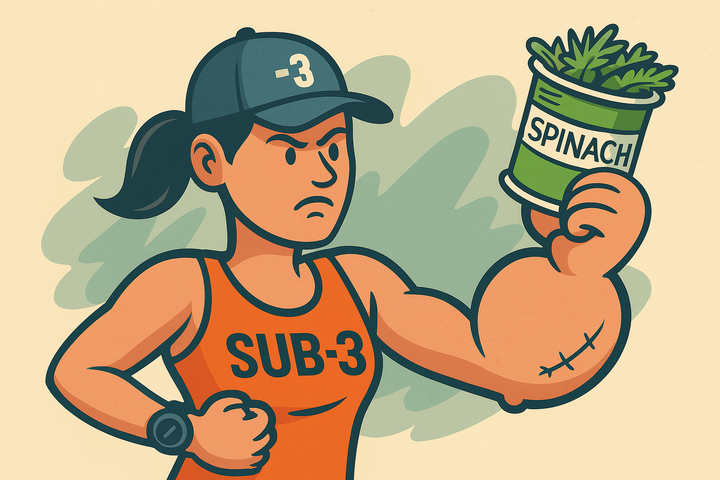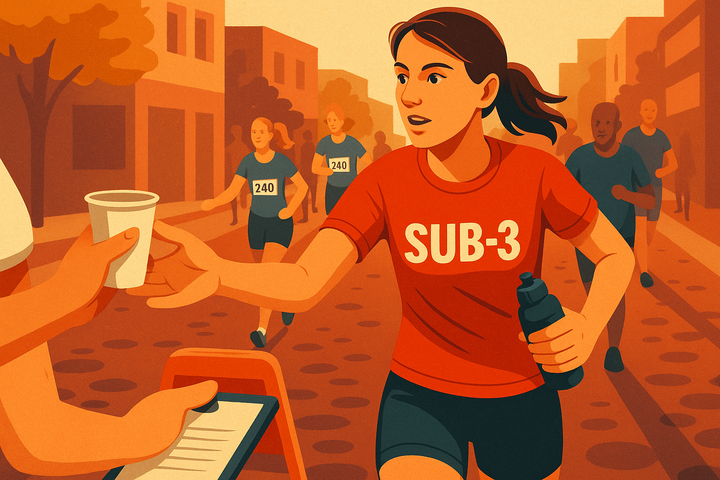What the IOC says about supplements — and what matters for sub-3 runners
The IOC’s landmark review identifies just five supplements with consistent performance benefits for trained endurance athletes. This guide breaks down what they are, how to use them, and what actually matters for sub-3 runners.

There are countless supplements aimed at runners — some helpful, some questionable, many under-researched. But in 2018, the International Olympic Committee (IOC) published a consensus statement on dietary supplements for high-performance athletes, in the British Journal of Sports Medicine. It remains one of the most rigorous and respected reviews available — and it highlights just five supplements with strong, consistent evidence of performance benefits in well-trained endurance athletes.
This isn’t a complete list of useful supplements — but it’s a solid starting point if you’re aiming to break three hours.
1. Caffeine
Well-established benefits for those undertaking endurance sport. The IOC found that caffeine improves endurance capacity, time-trial performance, perceived exertion and even cognitive function under fatigue. Benefits are seen across a range of sports, including long-distance running.
Use it for: Marathon focus, reduced perception of effort.
Typical dose: 3–6mg/kg body weight, ~60 minutes before exercise.
Caution: Avoid higher doses, which can impair performance and increase side effects.
2. Creatine monohydrate
Often associated with strength sports, but relevant for runners doing repeated high-intensity efforts. The IOC notes benefits in training quality, sprint ability, and lean mass maintenance — all of which can indirectly support endurance training blocks.
Use it for: Improved training quality (e.g. hills, gym work), recovery, muscular strength and power.
Typical dose: 20–25g per day (split into four intakes) for 5–7 days. This ‘loading’ phase is typically followed by a ‘maintenance’ phase of 3–5 g/day.
Caution: Slight water weight gain possible after loading (1-2kgs), so time it outside of race weeks.
3. Nitrate
The IOC confirms that dietary nitrate — from leafy green and root vegetables, including spinach, rocket salad, celery and beetroot— can reduce oxygen cost at submaximal intensities, improving running economy. Benefits are greater in sub-elite athletes and those with lower initial efficiency.
Use it for: Improvements of 4%–25% in exercise time to exhaustion and of 1%–3% in sport-specific TT performances lasting <40min in duration.
Typical dose: 310–560mg nitrate, 2–3 hours pre-run.
Caution: Potential for GI upset in susceptible athletes, appears to be an upper limit to the benefits of consumption.
4. Sodium bicarbonate
Acts as an extracellular buffer, reducing acidosis in high-intensity exercise. Particularly effective in efforts lasting 1–10 minutes (e.g. intervals, 5K to 10K races). Its relevance to marathon racing is limited, but it may aid during training.
Use it for: Interval training or short-distance racing
Typical dose: 0.2–0.4g/kg body weight, 60–150 minutes pre-run with food
Caution: High risk of GI distress — test well in advance
5. Beta-alanine
Increases muscle carnosine, which buffers intracellular acidity. Best suited for high-intensity bursts and threshold sessions rather than steady-state marathon pace — but can support overall race preparation.
Use it for: Threshold sessions, tempo runs, training under fatigue
Typical dose: 65mg/kg/day, ingested via a split-dose regimen
Caution: Paraesthesia (tingling) common at high doses
So what’s actually worth it?
You don’t need to take all five — and none of them are a magic bullet to get you to Sub-3. But if you’re already training hard and eating well, these are the supplements with the clearest track record at high-performance level. Personally, I use four of the five regularly - avoiding bi-carb due to the aforementioned GI issues - but always with a clear purpose in mind.
Others — like omega-3s, probiotics, or vitamin D — may still have benefits, especially for health and recovery. But these five are where the evidence for performance is strongest.
Used wisely, they might help you run 2:59 instead of 3:01. And for runners at this level, that’s more than enough.
Enjoyed this article? Help keep Sub-3 running — support us with a coffee.
To help fund the running of the site, Sub-3 is an Amazon Associate and earns from qualifying purchases. We only recommend gear or kit that has genuinely helped in our own running and that we believe is worth considering.



